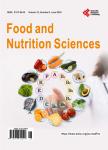Protein Quality of Amaranth Grains Cultivated in Ethiopia as Affected by Popping and Fermentation
Protein Quality of Amaranth Grains Cultivated in Ethiopia as Affected by Popping and Fermentation作者机构:Wolaita Sodo University Wolaita Sodo Ethiopia Center for Food Science and Nutrition Addis Ababa University Addis Ababa Ethiopia IRD UMR 204 “Prévention des Malnutritions et des Pathologies Associées” (Nutripass) IRD/Montpellier 2/Montpellier 1 Montpellier France CIRAD Département Persyst UMR Qualisud Montpellier France Micronutrient Initiative Addis Ababa Ethiopia
出 版 物:《Food and Nutrition Sciences》 (食品与营养科学(英文))
年 卷 期:2015年第6卷第1期
页 面:38-48页
学科分类:1002[医学-临床医学] 100214[医学-肿瘤学] 10[医学]
主 题:Amaranth Grain Indispensable Amino Acids Popping Fermentation Protein Digestibility Complementary Food
摘 要:The effect of popping and fermentation on protein quality of three different varieties of amaranth grains cultivated in Ethiopia was evaluated. Total lysine content of the grains was higher than that of commonly available cereals but close to that of legumes. Methionine and cysteine contents in the grains were also higher than that found in cereal and legume proteins. Percentage of total indispensable amino acids, excluding tryptophan, was 43% - 49%, which was higher than WHO reference pattern (31%). Popping resulted in 36% and 37% reduction in total lysine and cysteine contents, respectively, whereas fermentation reduced cysteine, lysine and methionine contents by 16%, 20% and 20%, respectively. From the free amino acids, histidine was the major indispensable amino acid but threonine was not detected. During popping, all free amino acids, except threonine, were reduced. On the other hand, fermentation significantly increased (p 0.01) most amino acids except arginine, which was significantly decreased (p 0.01), and tyrosine and glutamic acid, for which no change was observed. Popping decreased in vitro protein digestibility (IVPD) by 8.3% - 17.1% while fermentation increased IVPD by 4.8% - 7.5%. Substitution of amaranth for wheat and/or maize during complementary food formulation could contribute much to the daily requirements of indispensable amino acids of young children.



